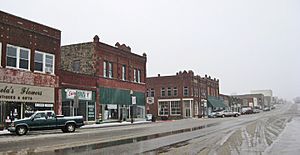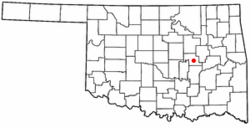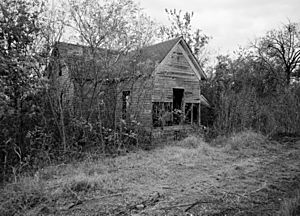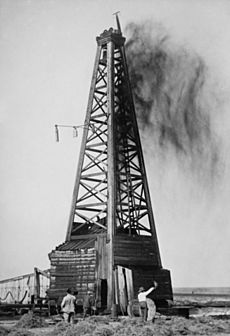Okemah, Oklahoma facts for kids
Quick facts for kids
Okemah, Oklahoma
|
|
|---|---|
|
City
|
|

West Broadway, Downtown
|
|
| Motto(s):
" Home of Woody Guthrie and the Woody Guthrie Folk Festival "
|
|

Location of Okemah, Oklahoma
|
|
| Country | United States |
| State | Oklahoma |
| County | Okfuskee |
| Area | |
| • Total | 3.20 sq mi (8.28 km2) |
| • Land | 3.10 sq mi (8.03 km2) |
| • Water | 0.10 sq mi (0.25 km2) |
| Elevation | 866 ft (264 m) |
| Population
(2020)
|
|
| • Total | 3,074 |
| • Density | 990.97/sq mi (382.59/km2) |
| Time zone | UTC-6 (Central (CST)) |
| • Summer (DST) | UTC-5 (CDT) |
| ZIP code |
74859
|
| Area code(s) | 539/918 |
| FIPS code | 40-54200 |
| GNIS feature ID | 2411310 |
| Website | okemahok.org |
Okemah is a city in Oklahoma, United States. It is the largest city and the main town of Okfuskee County. Okemah is famous as the birthplace of the folk music legend Woody Guthrie.
The Thlopthlocco Tribal Town, a Native American tribe, has its main office in Okemah. In 2020, about 3,078 people lived in Okemah.
Contents
History of Okemah
The land where Okemah is located was once home to the Osage and Quapaw tribes. By 1825, they gave their lands to the United States. In the 1830s, the area was given to the Creek Nation and the Thlopthlocco Tribal Town. This happened after many tribes were moved from the southeastern United States.
Okemah got its name from a Kickapoo Indian chief. In March 1902, Chief Okemah built a traditional bark house. He was waiting for the new town to open, which happened on April 22, 1902. The town was named after him. In the Kickapoo language, okemah means "things up high," like a high-ranking person or a town on high ground.
Before Oklahoma became a state, the Dawes Commission worked with five Native American tribes. From 1898 to 1906, they registered tribe members to give them pieces of tribal land. After this, any leftover tribal land was sold to new settlers.
Okemah was planned by people from Shawnee in March 1902. It was built on land owned by Mahala and Nocus Fixico, who were full-blood Creek. At that time, they didn't have the legal right to sell their land. This was because the land registration was still happening. But this didn't stop the town from developing.
The town officially opened on April 22, 1902. A post office opened in May, and the town became an official city in 1903. In 1904, rules about selling town lots were removed. The government paid the Fixicos for their land and gave legal ownership to those who bought lots.
In its first week, Okemah quickly grew. Many stores opened, including general stores, hardware stores, and drugstores. There were also places for wagons, lumber, and food. Two hotels were built, including the large Broadway hotel. This showed that Okemah was becoming an important town.
Okfuskee County was formed when Oklahoma became a state in 1907. Okemah was chosen as the county seat (the main town for the county government) in 1908.
Okemah's Firsts

Two railroad surveyors, Perry Rodkey and H.R. Dexter, chose the town's location. Dexter is known for picking the name Okemah. They thought two railroads would meet there, but only one did.
The town's first bank opened on April 22, 1902, in a tent. It later became the First National Bank. However, it closed in 1939 because of the Dust Bowl and the Great Depression.
Many people were "firsts" in Okemah:
- J. E. Galloway was the first mayor.
- Perry Rodkey was the first postman.
- E. D. Dexter was the first hotel operator.
- W. H. Dill ran the first telephone company.
- John D. Richards had the first hardware store.
- McGee Brothers set up the first cotton gin.
- E. E. Shook started the first lumberyard.
- The North Methodist church was the first church building.
- The first church service was Baptist, led by Rev. Black.
- Charles Barnclaw published the first newspaper.
Geography and Climate
| Weather chart for Okemah, Oklahoma | |||||||||||||||||||||||||||||||||||||||||||||||
|---|---|---|---|---|---|---|---|---|---|---|---|---|---|---|---|---|---|---|---|---|---|---|---|---|---|---|---|---|---|---|---|---|---|---|---|---|---|---|---|---|---|---|---|---|---|---|---|
| J | F | M | A | M | J | J | A | S | O | N | D | ||||||||||||||||||||||||||||||||||||
|
1.8
50
30
|
2.1
55
34
|
3.2
65
43
|
4.4
73
51
|
5.7
80
60
|
5.2
88
68
|
3.3
93
71
|
3.3
93
70
|
4.9
85
63
|
3.9
74
52
|
3.1
61
41
|
2.6
52
33
|
||||||||||||||||||||||||||||||||||||
| temperatures in °F precipitation totals in inches |
|||||||||||||||||||||||||||||||||||||||||||||||
|
Metric conversion
|
|||||||||||||||||||||||||||||||||||||||||||||||
Okemah covers about 2.7 square miles (7.0 square kilometers). Most of this area is land, with a small part being water.
| Climate data for Okemah, Oklahoma (1991–2020 averages) | |||||||||||||
|---|---|---|---|---|---|---|---|---|---|---|---|---|---|
| Month | Jan | Feb | Mar | Apr | May | Jun | Jul | Aug | Sep | Oct | Nov | Dec | Year |
| Record high °F (°C) | 82 (28) |
93 (34) |
94 (34) |
99 (37) |
97 (36) |
108 (42) |
114 (46) |
115 (46) |
111 (44) |
99 (37) |
88 (31) |
83 (28) |
115 (46) |
| Mean daily maximum °F (°C) | 49.7 (9.8) |
54.8 (12.7) |
64.6 (18.1) |
72.9 (22.7) |
79.8 (26.6) |
88.1 (31.2) |
93.0 (33.9) |
92.5 (33.6) |
84.8 (29.3) |
74.1 (23.4) |
61.4 (16.3) |
51.5 (10.8) |
72.3 (22.4) |
| Mean daily minimum °F (°C) | 30.3 (−0.9) |
34.4 (1.3) |
42.5 (5.8) |
50.5 (10.3) |
60.1 (15.6) |
67.5 (19.7) |
71.3 (21.8) |
70.0 (21.1) |
63.3 (17.4) |
52.1 (11.2) |
41.4 (5.2) |
33.1 (0.6) |
51.4 (10.8) |
| Record low °F (°C) | −10 (−23) |
−11 (−24) |
−2 (−19) |
21 (−6) |
35 (2) |
45 (7) |
53 (12) |
49 (9) |
34 (1) |
17 (−8) |
11 (−12) |
−9 (−23) |
−11 (−24) |
| Average precipitation inches (mm) | 1.76 (45) |
2.14 (54) |
3.20 (81) |
4.41 (112) |
5.72 (145) |
5.22 (133) |
3.28 (83) |
3.33 (85) |
4.85 (123) |
3.92 (100) |
3.08 (78) |
2.62 (67) |
43.53 (1,106) |
| Average snowfall inches (cm) | 2.9 (7.4) |
0.4 (1.0) |
0.6 (1.5) |
0 (0) |
0 (0) |
0 (0) |
0 (0) |
0 (0) |
0 (0) |
0 (0) |
0.3 (0.76) |
0.8 (2.0) |
5.0 (13) |
| Source: NOAA | |||||||||||||
Population of Okemah
| Historical population | |||
|---|---|---|---|
| Census | Pop. | %± | |
| 1910 | 1,389 | — | |
| 1920 | 2,162 | 55.7% | |
| 1930 | 4,002 | 85.1% | |
| 1940 | 3,811 | −4.8% | |
| 1950 | 3,454 | −9.4% | |
| 1960 | 2,836 | −17.9% | |
| 1970 | 2,913 | 2.7% | |
| 1980 | 3,381 | 16.1% | |
| 1990 | 3,085 | −8.8% | |
| 2000 | 3,038 | −1.5% | |
| 2010 | 3,223 | 6.1% | |
| 2020 | 3,074 | −4.6% | |
| U.S. Decennial Census | |||
In 2000, there were 3,038 people living in Okemah. There were 1,242 households, and 763 families. About 29.5% of households had children under 18.
The people living in Okemah were mostly White (69.09%), Native American (22.84%), and African American (2.37%). Some people were from other backgrounds or a mix of two or more.
The population was spread out by age. About 27.4% were under 18, and 20.5% were 65 or older. The average age was 37 years old.
Education in Okemah
School History
The first school in Okemah opened in 1902. It was paid for by people who wanted to support it. Classes were held in a store building. A proper school building was built later that year. This building was replaced by the Wilson School. The first public school started in 1904.
Another early public school was in a building where the American Legion building is now. Noble School was finished in 1907 and named after Miss Mae Noble. Okemah High School became officially recognized in 1912. It used the old Noble School building until a new high school was built in 1918. More buildings for the high school, like a band shop and a vocational building, were added later.
Parks, Recreation, and Events
Okemah Lake is north of town. It's a city lake where you can go swimming, boating, hunting, fishing, and camping.
Okemah’s Municipal Park has picnic tables and playground equipment. It was built in 1935 by the WPA, a government program that created jobs during tough times.
Two fun events happen every year in Okemah:
- Pioneer Days are held on the last weekend of April.
- The Woody Guthrie Folk Festival, also called WoodyFest, takes place every July.
Transportation
Okemah is easy to get to because it's located where Interstate 40 and State Highway 27 meet.
The Okemah Airport (FAA Identifier: F81) is two miles south of town. It has a runway that is 3,400 feet long.
Notable People from Okemah
Many interesting people have come from Okemah, including:
- Larry Coker - A football coach.
- Evan Felker - The lead singer for the country music band Turnpike Troubadours.
- John Fullbright - An Americana singer and songwriter.
- Woody Guthrie - A famous folk singer.
- Robert Higgs - An economic historian.
- Leon C. Phillips - A former Governor of Oklahoma.
- William Reid Pogue - An astronaut.
- Shawna Russell - A country singer and songwriter.
Historic Places in Okemah
These places in Okemah are listed on the National Register of Historic Places, meaning they are important historical sites:
- Okemah Armory
- Okfuskee County Courthouse
See also
 In Spanish: Okemah (Oklahoma) para niños
In Spanish: Okemah (Oklahoma) para niños



